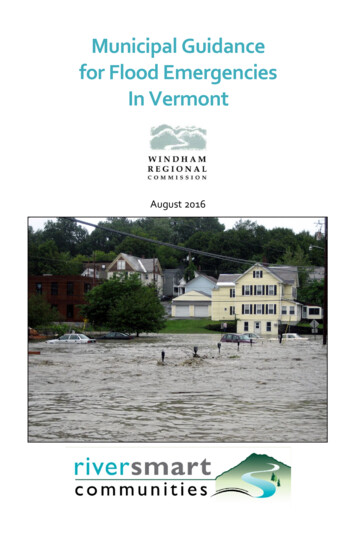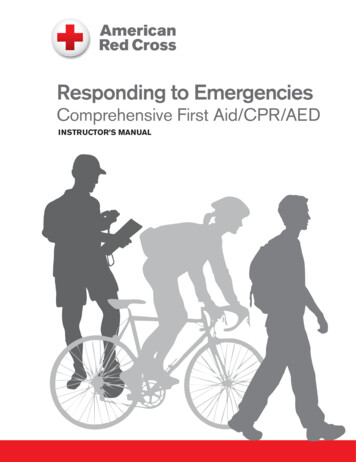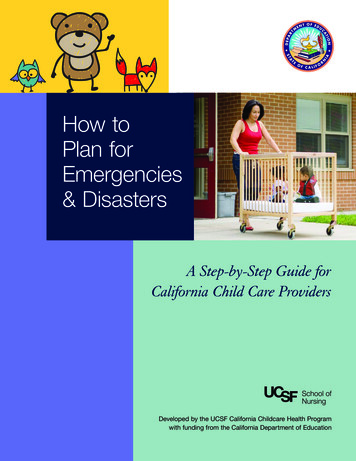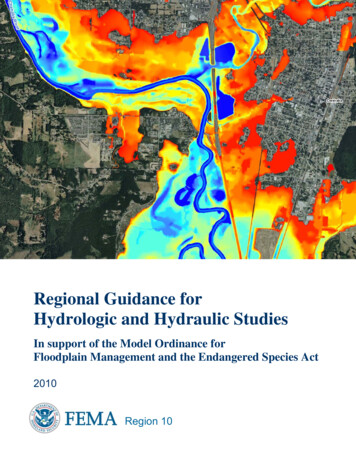
Transcription
Municipal Guidancefor Flood EmergenciesIn VermontAugust 2016
This document was re-drafted for Vermont from a documentoriginally developed for Western Massachusetts by DeerfieldWatershed Creating Resilient, an ad hoc group of local politicalleaders, residents, scientists from UMass, engineers from NRCS andmany others. It is encouraged that towns save this document to aserver for electronic access, and include a hard copy in the town’sLEOP binder.Thanks and AcknowledgementsThank you to Deborah Shriver Consulting for sharing the originaldocument and editing this booklet, and to Deerfield WatershedCreating Resilient Communities and the University ofMassachusetts RiverSmart Communities for providing theopportunity to develop and distribute it. Thank you to the VermontDepartment of Emergency Management and Homeland Securityand the Vermont Agency of Natural Resources for their input intothe development of this document. Funding in support of this workwas provided by USDA NIFA.Cover photo: Flooding during Tropical Storm Irene, 2011Photo credit: Jeff Nugent, Windham Regional CommissionThis publication available at https://extension.umass.edu/riversmart/manuals
Table of ContentsAdvance Preparations I: Have these in place . 1Advance Preparations II: Major storm is forecast with high risk of flooding . 5Activation Time: During the Storm . 7After the Storm: Recovery . 9Acronyms: . 11Resources: . 12Remains of a home destroyed by Tropical Storm Irene, 2011Photo credit: Jeff Nugent, Windham Regional Commission
Advance Preparations I: Have these in placeTraining: Agents for Boards of Health, EMDs, Zoning Administrators, Plannersand others are eligible to receive free trainings through theDepartment of Homeland Security. Programs are available for floodresponse and other emergencies. (Transportation, room, board andprogram costs are paid for by DHS.) Additional trainings are availablefrom the State of Vermont here. Town Administrator/EMD: Be sure the Selectboard, fire, police,highway, DPW and emergency personnel have had IncidentCommand System (ICS) training, available through FEMA. ICSprovides a consistent framework and process for responding toemergencies among local, state, federal agencies, non-profit sectorsand faith-based organizations. ICS-100 and ICS-200 are available online and can be done in a few hours. Town Administrator/EMD: Set up and get trained in VTAlert. VTAlertis a web-based system that provides a portal through whichinformation can be disseminated by state and local authorities to thepublic, including schools and colleges, state, local, and federalgovernment, and first responders. It allows the public to sign up forand receive notifications through a number of delivery systems suchas text, e-mail, or telephone. Town staff should have awareness of the Emergency ProtectiveMeasures (EPM) Rule in effect in Vermont. Emergency protectivemeasures can be taken by municipalities to preserve life or protectproperty from severe damage and may proceed without priorauthorization from ANR, but the measures taken must meet thestandards established in the Rule and be minimized to that necessaryto protect life and property. The measures must be approved by amember of the municipal legislative body and must be reported to theAgency of Natural Resources within 24 hours using the onlinereporting form. Contact a River Management Engineer or contact theRivers Program at ANR.WSMDRivers@vermont.gov or 802-4906195. EPM informational video is here. Town staff should have familiarity with the Natural ResourcesConservation Service’s Emergency Watershed Protection programand the staff at their local Vermont NRCS office. This program’sobjective is to assist sponsors and individuals in implementingemergency measures to relieve imminent hazards to life and propertycreated by a natural disaster.1
Selectboard/ Town Staff/ Zoning/Floodplain Administrator: It isimportant to be familiar with the Special Flood Hazard Area (SFHA)and River Corridor mapping and locations for your town, in addition tosharing amongst yourselves any local knowledge of unmapped floodrisk areas. Know which roads, bridges and culverts are at risk.Maintain hard copies of all maps with highway department, EMS, andlocal police, and/or sheriff or state police.Town Website / Plans / Policies: Town Administrator/Staff/EMD: Create an unpublished webpage forthe Town website that includes emergency contact numbers andother emergency information that can be activated duringemergencies. Selectboard/Town Staff: Make sure you have a Continuity ofOperations Plan (COOP) in place so that basic municipal services canbe maintained during an emergency. EMD/Selectboard: Maintain an up-to-date Local EmergencyOperations Plan (LEOP). This Plan needs to be updated by the EMDand approved/adopted by the Selectboard in a warned meeting. Thismust take place annually between Town Meeting Day and May 1st. Animal Control Officer/Town Staff: Plan for how to handle/care foranimals during a disaster. Completion of Appendix B7 of the LEOP willassist in doing this. Vermont Disaster Animal Response Team(VDART) also has resources to assist towns in planning for animalsand setting up animal shelters. EMD: Contact your regional planning commission’s EmergencyPlanner for information on getting municipal trainings, assistancewith developing emergency plans, information about the LocalEmergency Planning Committee (LEPC) and CommunityOrganizations Active in Disaster (COAD), and other emergencymanagement related questions. Your RPC can be found here. Town Administrator/Staff/EMD: Maintain a list of extra fire, police,highway equipment drivers who can be called upon in an emergency.Check with your insurance company on coverage for these workers. Selectboard: If not already outlined in the Town’s personnel policy,create a Town policy discussing expectations of staff duringemergencies. Is everyone expected to pitch in? Will they get paidovertime?Records: Road Foreman/Commissioner: Maintain an up-to-date culvert andbridge inventory with photographs of existing conditions. If one is notalready in place, set up a system to keep detailed records of town2
infrastructure repair costs. This is important information to havewhen seeking disaster repair reimbursement and/or grant funding forupgrades or retrofits. Your inventory may be online atwww.vtculverts.org.Road Foreman/Commissioner: Maintain a highway departmentequipment list. After a storm event, reimbursement may be availablefor use of backhoes, dump trucks, etc.Town Clerk/Treasurer/Listers: Consider the vulnerability of thelocation of town records. If necessary, store records in an alternate,less vulnerable location for safe keeping.EMD: Know your town’s vulnerable populations and their needsduring events when power may be out or roads closed for extendedperiods of time. Keeping an updated vulnerable populations list is oneway to do this. Towns can also provide information to individualsabout registering for Citizen Assistance Registration for Emergencies(CARE).Zoning/Floodplain Administrator: Know what buildings are at riskstructurally or subject to inundation.Roles: Town Administrator/Selectboard/EMD: Predetermine a “VolunteerCoordinator” and train them as part of your town’s EmergencyOperations Center (EOC) response team. This will eliminate confusionfollowing an event and also increase utilization of volunteer support.The Volunteer Coordinator should proactively make connections withlocal recovery groups that may be looking for volunteers following anevent. Selectboard/Town Staff: Designate and train a public informationofficer (PIO) – someone with written skills and public speaking abilitywho will issue statements to the media during emergencies. Have alist of local media contacts available and keep it up to date.Emergency Operations Center: Ensure your local EOC is adequately equipped with emergency radiocommunication capability (maybe at Fire Department) that allows forcommunications with police, fire, selectboard and highwaydepartment vehicles. Local EOC should also have back-up powersource and technology capable of maintaining uninterruptedcommunication with the State Emergency Operations Center (SEOC).Sheltering: EMD/Town Staff: Have local shelters pre-planned and their locationsmade known to residents. When choosing and establishing shelters,3
consider individuals with functional needs, pets, and backup power.Shelters should be noted in the town’s annually updated LEOP in theplanning tasks. Contact the American Red Cross for shelter bestpractices.Vermont has eight regional emergency shelters, but these can only beopened with agreement from the host town, facility, and AmericanRed Cross. If a community doesn’t have a shelter and needs oneopened during a disaster, they can contact the Red Cross through theSEOC at 1-800-347-0488. This may result in opening a regionalshelter, sending folks to a nearby shelter, or other situationdependent options.Animal Control Officer/EMD/Town Staff: Plan for how to handle/carefor animals during a disaster. Talking with shelter operators abouthow/where animals can be housed is the first step. Work with willinglocal farmers to find shelter locations for large animals that may needto be evacuated from vulnerable locations. Vermont Disaster AnimalResponse Team (VDART) has resources to assist towns in planning foranimals and setting up animal shelters.Recovery: Road Foreman/Commissioner: Have pre-bid contracts for largeequipment, materials (gravel, rock) and contractor services to avoidprocurement delays. Can bid once a year. Town Administrator/Town Staff: Have a pre-determined debrismanagement site identified in your community’s solid wasteimplementation plan (SWIP). Contact your Solid Waste District orprivate hauler for appropriate protocol if your town does not have aSWIP. Develop and maintain a supportive relationship with local/regionalEMS and Search and Rescue groups serving your town.Tropical Storm Irenedamage, 2011Photo credit: Joe Flynn,Department of Public Safety4
Advance Preparations II: Major storm is forecastwith high risk of floodingHighway Department: Ensure there is an adequate inventory of “Road Closed” signs. Ready“Road Closed” signs and place face down near locations susceptible toflood damage. Check and clear debris from swales, turn outs, catch basins and otherdrainage structures. Photograph catch basins (can use GPS units orsmart phone with date/time stamp) to document pre-stormcondition. Document mileage of highway department trucks, and otherequipment at the start of the storm in order to be eligible forreimbursement for costs associated with their use during and afterthe storm. Either activate or alert back-up/extra staff of possible activation. Stay in contact with your VTrans District Tech and ANR RiverEngineer to advise them of possible issues and the need foremergency repairs.Selectboard/Emergency Management Director/Town Staff: Watch river gauge information. Know at what discharges roads beginto flood. Alert police and highway department about potential floodemergency. Hold pre-event meeting with police, highway, selectboard, fire andemergency services personnel to share information and coordinateactions. Either activate or alert back-up/extra staff of possibleactivation. Have the “Volunteer Coordinator” begin to line upvolunteers and create a schedule for shifts. Activate local EOC staff. Gather provisions needed for EOC staff. Stock up on bottled water. Contact local restaurants that have volunteered to cook foremergency personnel during and immediately following a stormevent. Reach out to local faith community to solicit their help in aidinghomebound residents. Begin keeping track of all costs, including donated time, food andmaterials, as it may be eligible to count as ‘local match’ for FEMAreimbursement if a federal disaster is declared. Contact USDA, Natural Resource Conservation Service personnel atyour local NRCS office to alert them to possibility of flood damages.5
NRCS may activate extra staff to go to flood damage sites to evaluatethem for restoration funding via the Emergency WatershedProtection (EWP) Program. EWP funds can be used to make repairswhere infrastructure is damaged or threatened. These funds can beaccessed where damage has occurred due to any severe event. It neednot be a federally declared emergency but non-federal disasters areput on a waitlist and not immediately funded. However, NRCS staffmust evaluate damage sites before any repairs are made by the town.Call NRCS staff as soon as possible after the storm (Rob Allen, 802951-6796 x232 or rob.allen@vt.usda.gov).Local Police, Sheriff and/or State Police: Either activate or alert back-up/extra officers of possible activation. Prepare and distribute to officers a form for people to sign who refuseto evacuate a flooded area.Spring 2011 flooding in VermontPhoto credit: Vermont Civil Air Patrol6
Activation Time: During the StormHighway Department: Maintain contact with your local EOC and selectboard. Find and remove downed trees. Report downed electrical wires. Maintain lines of communication with your VTrans District Tech andregional planning commission. Report all damages as requested andby the time given. Record keeping is vital. Keep track of all materials, equipment time,and staff overtime, as it may be eligible to count as ‘local match’ forFEMA reimbursement if a federal disaster is declared. Coordinate with town staff on any needed Emergency ProtectiveMeasure (EPM) authorizations for emergency repairs required toaddress flood-related imminent threats to life or imminent severedamage to property. Adhere to all requirements of this process asoutlined in LEOP appendix C2. EPMs must be approved by a memberof the municipal legislative body and must be reported to ANR within24 hours using the online reporting form. Contact a RiverManagement Engineer or contact the Rivers Program atANR.WSMDRivers@vermont.gov or 802-490-6195.Local Police, Sheriff and/or State Police: Maintain contact with EOC and selectboard. Conduct well-being checks on homebound and at-risk populations.Take those needing assistance to local shelters. Set up “Road Closed” signs where necessary. Determine when and where flood evacuation is needed. Evacuatepeople and animals from flood-inundated areas and take them toshelters. Once the Governor declares a state of emergency, theGovernor has the authority to order the evacuation of persons livingor working within all or a portion of an area for which a state ofemergency has been proclaimed. Vermont does not have a specificprocedure in place regarding enforcement of an evacuation order.Selectboard/Emergency Management Director/Town Staff: Be at EOC and maintain communication with police, highway, fire andemergency personnel. If needed, the town can submit a request for the Governor to declarean emergency (using the form in appendix A of the LEOP). Multipletowns requesting an emergency declaration is a signal to the governorthat the SEOC should be opened, an emergency should be declared7
for the state, and they should consider requesting a PreliminaryDamage Assessment (PDA) from FEMA.Track costs during emergency response, including donated time, foodand materials, as it may be eligible to count as ‘local match’ for FEMAreimbursement.Designate an emergency shelter, if necessary. During the event, atown may activate an emergency shelter. If a community doesn’thave a shelter and needs one opened during a disaster, it can contactthe Red Cross through the SEOC at 1-800-347-0488. This may result inopening a regional shelter, sending folks to a nearby shelter, or othersituational dependent options. In addition to SEOC, notify yourregional planning commission when any shelter is being opened.Notify your regional planning commission/SEOC of all damages usingthe situational report form (appendix A2 of the LEOP). Your regionalplanning commission and/or the SEOC will give you direction,including submission deadlines and methods.Any requests for resources that exceed mutual aid can becommunicated to the SEOC by calling 1-800-347-0488.If needed, contact DEMHS, using the SEOC hotline, and requestactivation of a Community Emergency Response Team (CERT). Thesevolunteers can perform non-medical assistance via the IncidentCommand System (ICS). CERT can direct traffic, assist in shelters andprovide other services. DEMHS must activate these teams in order forthem to be covered under DEMHS liability coverage.Zoning Administrator/Floodplain Administrator: Check status of buildings that are at risk structurally or subject toinundation.Tropical Storm Irene damage, 2011Photo credit: Jeff Nugent, Windham Regional Commission8
After the Storm: RecoveryZoning Administrator/Floodplain Administrator: Local zoning bylaws and floodplain regulations should be utilizedduring consideration of repair/replacement options for damagedproperties and infrastructure. Local permits may be needed,depending on your town. Substantial Damage determinations need to be completed andhomeowners must be told if their home is substantially damagedASAP (includes labor even if DIY) because that will change how theycan complete repairs. Information on how to make thatdetermination can be found here.Board of Health: Inspect crops for contamination. Be sure crops contaminated by flooddebris are plowed under or removed. For assistance in evaluatingcrops contact the VT Department of Health at the SEOC: 1-800-3470488 Contact Vermont Agency of Agriculture, Food and Markets forrequirements for burying or disposing of animal carcasses, at theSEOC: 1-800-347-0488 First line of communication for any questions about potential publichealth issues should be the SEOC, and they can get in contact withthe VT Department of Health for further assistance. Centers for Disease Control Emergency Response Hotline (24-hour):1-770-488-7100. The USDA’s Farm Service Agency (FSA) can provide disaster reliefassistance for farmers. The FSA may offer Emergency ConservationProgram cost-shares to eligible producers, depending on fundingallocations, to help repair farmland and conservation facilitiesdamaged by a natural disaster occurrence. A Federal Declaration isnot required to implement this program. More information can befound here or by contacting your county FSA office.Selectboard/Emergency Management Director/Town Staff: Report spills or releases of hazardous materials or waste 24/7 bycalling the Vermont HAZMAT Hotline at 1-800-641-5005 or by callingthe ANR Spills Program during business hours at 802-828-1138. TheANR Spill Program assesses the environmental impact of hazardousmaterials spills, oversees the cleanup of spills, and enforcesenvironmental regulations triggered by spills. By calling the HAZMATHotline and providing the information, the State will make sure thatthe right groups know about it and can assist in response.9
Any release which impacts surface water must also be reported 24/7to the National Response Center (NRC) at 1-800-424-8802.Information about the triggers for reporting hazardous material spillsor releases can be found here.Wastewater releases should be reported to the wastewater treatmentfacility operator, and then be reported through the ANR onlineservices portal ANR Online.Contact your responsible COAD for additional recovery assistance ifneeded. Your regional planning commission can assist with makingthis contact.Assistance to landowners who have experienced severe propertydamage may be available through the Natural ResourcesConservation Service. This work must have a state or localgovernment sponsor and serve to reduce threats to life and property,be economically and environmentally defensible and sound from anengineering standpoint. NRCS covers 75% of costs and the sponsor isresponsible for the remaining 25%. Applications for assistance mustbe submitted within 60 days of the disaster. Contact your local NRCSoffice for assistance.Direct all volunteers to your town’s pre-determined VolunteerCoordinator for how they can assist the town and/or local recoverygroups.FEMA provides 75% of the cost for emergency work and permanentwork after a declared disaster. Emergency work categories includedebris removal and emergency protective measures. Examples ofemergency protective measures include sandbagging, closing roads,and a quick repair to a road. Permanent work categories includeupgrades or retrofits of road systems (bridges, culverts, roads), watercontrol facilities (levees), equipment, public facilities, or parks,recreational, and other (cemeteries). More information about thisreimbursement can be found here.When a Federal Disaster Declaration is made, FEMA opens up aHazard Mitigation Grant Program (HMGP) funding source. Thisprogram requires local governments to apply on behalf of applicants,or for themselves. This is a state competitive grant program, whichpays 75% of eligible costs and requires a 25% local match, which thetown either directly provides or is responsible for receiving. Thisprogram can be used for projects that serve to mitigate futuredamage from natural disasters. A Benefit/Cost Analysis is required forthis grant, for which records must be available to complete.Information can be found by contacting your regional planningcommission or Vermont State Hazard Mitigation staff.10
Highway Department: Maintain line of communication with your VTrans District Tech.Report all damages as requested by VTrans. Record keeping is vital. Take pictures before completing any repairs.Keep track of all materials, equipment time, and staff overtime, as itmay be eligible to count as ‘local match’ for FEMA reimbursement if afederal disaster is declared. Coordinate with town staff on any needed Emergency ProtectiveMeasure (EPM) authorizations for emergency repairs required toaddress flood-related imminent threats to life / imminent severedamage to property. Adhere to all requirements of this process asoutlined in appendix C2. EPMs must be approved by a member of themunicipal legislative body and must be reported to the Agency within24 hours using the online reporting form. Contact a RiverManagement Engineer or contact the Rivers Program atANR.WSMDRivers@vermont.gov or 802-490-6195.Acronyms:ANR – VT Agency of Natural ResourcesCERT – Community Emergency Response TeamCOOP – Continuity of Operations PlanCOAD – Community Organizations Active in DisasterDEMHS – VT Division of Emergency Management and Homeland SecurityDHS – Federal Department of Homeland SecurityEMD – Emergency Management DirectorEMS – Emergency Medical ServicesEOC – Emergency Operations Center (local)EPM – Emergency Protective MeasuresFEMA – Federal Emergency Management AgencyFSA – USDA’s Farm Service AgencyGPS – Global Positioning SystemICS – Incident Command SystemsLEOP – Local Emergency Operations PlanNRC – National Response CenterNRCS – Natural Resources Conservation Service (Division of USDA)PDA – Preliminary Damage AssessmentSEOC – State Emergency Operations CenterSFHA – Special Flood Hazard AreaSWIP – Solid Waste Implementation PlanUSDA – United States Department of AgricultureVDART – Vermont Disaster Animal Response Team11
Resources:Vermont DEMHS: http://demhs.vermont.gov/Vermont Division of Fire Safety: http://firesafety.vermont.gov/VTrans: http://vtrans.vermont.gov/Vermont Agency of Natural Resources: http://anr.vermont.gov/Regional Planning Commission map and list: http://www.vapda.org/Natural Resources Conservation Service: http://www.nrcs.usda.govFEMA Emergency Management Institute: https://training.fema.gov/USDA Farm Service Agency: https://www.fsa.usda.gov/indexSpring 2011 floodsPhoto credit: Mike Cannon, Department of Public Safety12
provides a consistent framework and process for responding to emergencies among local, state, federal agencies, non-profit sectors and faith-based organizations. ICS-100 and ICS-200 are available on- . facility, and American Red Cross. If a community doesn't have a shelter and needs one opened during a disaster, they can contact the Red .










